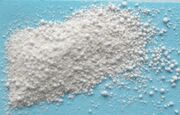Difference between revisions of "Stannic oxide"
| (2 intermediate revisions by the same user not shown) | |||
| Line 1: | Line 1: | ||
| + | [[File:SnO2powder-wiki.jpg|thumb|Tin (IV) oxide powder<br>Materialscientist at English Wikipedia]] | ||
== Description == | == Description == | ||
| − | White powder that is often incorrectly called tin oxide. Stannic oxide, or tin dioxide, occurs in nature as the mineral [[cassiterite|cassiterite]]. It is used as an abrasive, sometimes in mixtures with [[lead oxide]], for polishing [[glass]], [[marble]], [[silver]], and jewelry. Stannic oxide is also used as a [[mordant|mordant]] for dyeing fabrics and as a weighting agent. Additionally, it is used as an opacifier in [[glass|glass]] and glazes to produce a translucent milky color. Tin dioxide reacts with chrome oxides to produce a ruby red color in glass and glazes. As a paint pigment, [[Tin white]] was also used in some watercolor paintings and manuscript illuminations until the early 17th century, but was discontinued because it can blacken in sunlight and when mixed with [[lead%20white|lead white]]. | + | White powder that is often incorrectly called tin oxide. Stannic oxide, or tin dioxide, occurs in nature as the mineral [[cassiterite|cassiterite]]. It is used as an abrasive, sometimes in mixtures with [[lead oxide]], for polishing [[steel]], [[glass]], [[marble]], [[silver]], and jewelry. Stannic oxide is also used as a [[mordant|mordant]] for dyeing fabrics and as a weighting agent. Additionally, it is used as an opacifier in [[glass|glass]] and glazes to produce a translucent milky color. Tin dioxide reacts with chrome oxides to produce a ruby red color in glass and glazes. As a paint pigment, [[Tin white]] was also used in some watercolor paintings and manuscript illuminations until the early 17th century, but was discontinued because it can blacken in sunlight and when mixed with [[lead%20white|lead white]]. |
== Synonyms and Related Terms == | == Synonyms and Related Terms == | ||
| Line 43: | Line 44: | ||
==Resources and Citations== | ==Resources and Citations== | ||
| + | * Wikipedia: [https://en.wikipedia.org/wiki/Tin(IV)_oxide Tin(IV)oxide] (accessed May 2023) | ||
* G.Wharton, S.Lansing, W.Ginell, "A Comparative Study of Silver Cleaning Abrasives" ''JAIC'' 29:13-31, 1990. [http://aic.stanford.edu/jaic/articles/jaic29-01-002_indx.html LINK] | * G.Wharton, S.Lansing, W.Ginell, "A Comparative Study of Silver Cleaning Abrasives" ''JAIC'' 29:13-31, 1990. [http://aic.stanford.edu/jaic/articles/jaic29-01-002_indx.html LINK] | ||
* G.S.Brady, ''Materials Handbook'', McGraw-Hill Book Co., New York, 1971 Comment: p. 810 | * G.S.Brady, ''Materials Handbook'', McGraw-Hill Book Co., New York, 1971 Comment: p. 810 | ||
Latest revision as of 06:58, 19 May 2023
Description
White powder that is often incorrectly called tin oxide. Stannic oxide, or tin dioxide, occurs in nature as the mineral Cassiterite. It is used as an abrasive, sometimes in mixtures with Lead oxide, for polishing Steel, Glass, Marble, Silver, and jewelry. Stannic oxide is also used as a Mordant for dyeing fabrics and as a weighting agent. Additionally, it is used as an opacifier in Glass and glazes to produce a translucent milky color. Tin dioxide reacts with chrome oxides to produce a ruby red color in glass and glazes. As a paint pigment, Tin white was also used in some watercolor paintings and manuscript illuminations until the early 17th century, but was discontinued because it can blacken in sunlight and when mixed with Lead white.
Synonyms and Related Terms
stannic anhydride; tin peroxide; tin dioxide; tin oxide (sp); tin (IV) oxide; stannic acid; putty powder; putty; jeweler's putty; white tin oxide; flowers of tin; polishing powder; tin ash
Risks
- Noncombustible.
- Contact may cause irritation.
- Fisher Scientific: SDS
Physical and Chemical Properties
Soluble in concentrated sulfuric acid, hydrochloric acid. Insoluble in water.
| Composition | SnO or SnO2 - xH2O |
|---|---|
| CAS | 18282-10-5 |
| Mohs Hardness | 6.0-7.0 |
| Melting Point | 1127 C |
| Density | 6.6 - 6.9 g/ml |
| Molecular Weight | mol. wt. = 150.71 |
Comparisons
Properties of Common Abrasives
Resources and Citations
- Wikipedia: Tin(IV)oxide (accessed May 2023)
- G.Wharton, S.Lansing, W.Ginell, "A Comparative Study of Silver Cleaning Abrasives" JAIC 29:13-31, 1990. LINK
- G.S.Brady, Materials Handbook, McGraw-Hill Book Co., New York, 1971 Comment: p. 810
- Richard S. Lewis, Hawley's Condensed Chemical Dictionary, Van Nostrand Reinhold, New York, 10th ed., 1993 Comment: density=6.6-6.9
- Susan E. Schur, Conservation Terminology: A review of Past & Current Nomenclature of Materials, Technology and Conservation, Spring (p.34-39); Summer (p.35-38); Fall (p.25-36), 1985
- Michael McCann, Artist Beware, Watson-Guptill Publications, New York City, 1979
- Henry Hodges, Artifacts: An Introduction to Early Materials and Technology, Ronald P. Frye, Kingston, Canada, 1988
- The Merck Index, Martha Windholz (ed.), Merck Research Labs, Rahway NJ, 10th edition, 1983 Comment: entry 8933
- C.W.Chesterman, K.E.Lowe, Audubon Society Field Guide to North American Rocks and Minerals, Alfred A. Knopf, New York, 1979 Comment: hardness=6-7; density = 6.8-7.1
